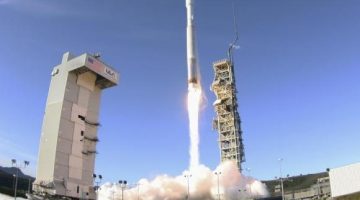Podcast – (Source: aviationweek.com) – Interview With Space Development Agency Director Jen DiMascio Steve Trimble Lee Hudson November 10, 2020
Space Development Agency (SDA) director Derek Tournear joins Aviation Week editors on Check 6 to discuss how its system of space tracking and transport satellites will revolutionize the U.S. military and the challenges it will face along the way.
TO LISTEN GO TO >>> PODCAST
Transcript’s Abstract
Jen DiMascio:
Hi and welcome to the Check 6 Podcast. I’m Jen DiMascio, the Executive Editor for Defense and Space and I’m here with Pentagon Editor, Lee Hudson, Defense Editor, Steve Trimble and a very special guest, the Head of The Pentagon Space Development Agency, Derek Tournear. We’re so glad to have you with us. Back in the summer, you joined us for a fascinating webinar and we’re very grateful you have some more time to sit down with us especially given all the agency has accomplished since then. Awarding contracts for the initial set of SDA transport layer satellites, tracking layer spacecraft and optical links. Maybe you can just talk a little bit about what’s next for you and then we’ll go on to have more questions for you.
Derek Tournear:
Thank you, Jen. It’s my pleasure. I’m always happy to talk about what we’re focused on and what we’re working on at the Space Development Agency. You’re right we’ve been very busy. Awarded a lot of contracts and what we’re essentially focused on, keep in mind, the two main capabilities that we plan on fielding are beyond line of sight targeting for time-sensitive targets. We want to be able to detect and track and target things such as mobile missile launchers and ships all from space. We want to be able to do all of that and then send those data down directly to a weapons platform. And then the second capability is to field the exact same thing, except now instead of targeting mobile missile launchers and ships, we’re actually targeting hypersonic glide vehicles and new advanced missile threats. So what we’re looking to do, is we’re looking to put systems in place that can do those missions as rapidly as possible as early as October of 2022.
And then every two years thereafter continue to spiral and develop and put out new capabilities based on the latest technologies or the latest threats. So you’re right. We have already fielded… Oh excuse me. We’ve already put on contract the capabilities to do the transport layer, which is the data transport to allow us to do the low latency communication that enables all of these missions, and the wide field of view, IR, infrared sensing systems that will actually detect and track the missiles. And then we can track those, send those data to transport and send them to the weapons platform. So the next steps we have are to actually put on contract the mission specific applications although that is a lot of magic has to happen in software to be able to close that kill chain. So we are currently evaluating proposals to be able to do those software applications so that we can put folks on contract to push forward and then start developing those.
And then after that it is just cranking out and making sure that the folks on contract along with our government teammates at the Naval Research Laboratory, can all perform and develop and build these systems with the goal being that these will all be launched in October of 2022. And in August of 2021, we’re actually going to go out for a solicitation for the Tranche 1, which would be the satellites that we’ll then launching in 2024. So that’s kind of what is on our very near term and medium term horizons. (…)
Go to source and read full transcript >>> https://aviationweek.com/special-topics/air-dominance/podcast-interview-space-development-agency-director
Photo © https://sociable.co/technology/darpa-iarpa-scientist-to-direct-new-space-development-agency/












